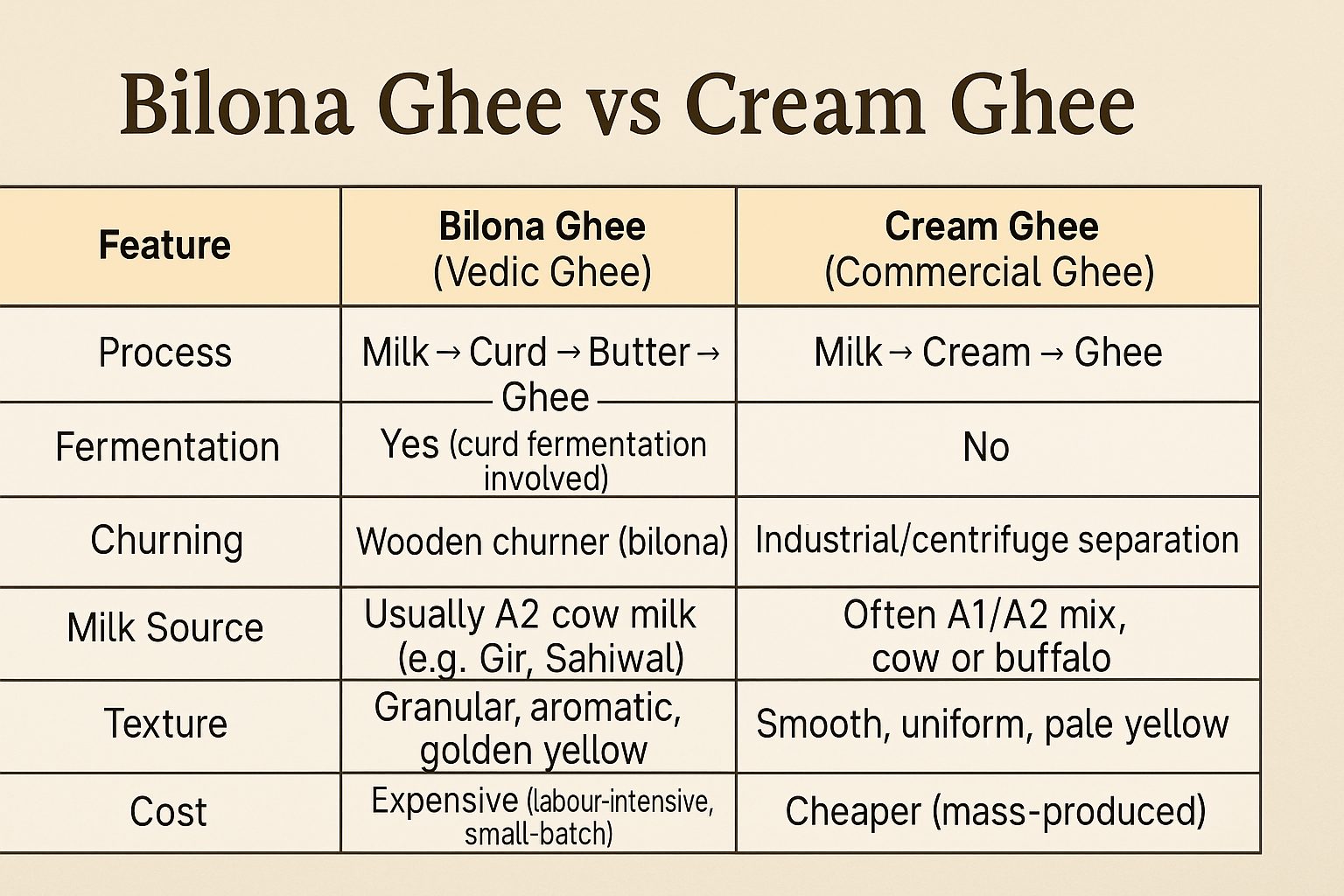Bilona Ghee vs Cream Ghee: A Complete Ayurvedic Comparison

Ghee has held a revered place in Indian households and Ayurvedic medicine for centuries. However, not all ghee is created equal. The method of preparation defines its digestive potency, therapeutic properties, and overall quality. Two common types of ghee available today are Bilona Ghee and Cream Ghee.
What is Bilona Ghee?
Bilona Ghee is prepared using the traditional Vedic method, where milk is turned into curd, the curd is hand-churned into butter, and the butter is then gently heated to extract ghee. This process involves natural fermentation and retains the pranic energy (life force) of the milk.
What is Cream Ghee?
Cream Ghee, commonly available in supermarkets, is made by directly heating milk cream (malai) to extract ghee. It skips the curd and churning stages, which are essential in Ayurvedic preparation. This type is usually mass-produced for cooking purposes.
Comparison Table: Bilona Ghee vs Cream Ghee
| Feature | Bilona Ghee (Vedic Ghee) | Cream Ghee (Commercial Ghee) |
|---|---|---|
| Process | Milk → Curd → Butter → Ghee | Milk → Cream → Ghee |
| Fermentation Stage | Yes (curd fermentation involved) | No |
| Churning | Wooden churner (bilona) used | Industrial/centrifuge separation |
| Milk Source | Usually A2 cow milk (e.g. Gir, Sahiwal) | Often A1/A2 mix, cow or buffalo |
| Texture | Granular, aromatic, golden yellow | Smooth, uniform, pale yellow |
| Flavour | Rich, nutty, pure | Mild, often bland |
| Nutrient Retention | High (due to slow cooking & fermentation) | Lower |
| Ayurvedic Use | Ideal for Panchakarma, Rasayana therapy, puja | Not suitable for medicinal or ritual use |
| Shelf Life | Slightly shorter, natural preservation | Longer, sometimes processed with preservatives |
| Cost | Expensive (labour-intensive, small-batch) | Cheaper (mass-produced) |
Ayurvedic Significance of Bilona Ghee
Ayurveda classifies Bilona Ghee as sattvic—it promotes clarity, calmness, and nourishment. Here’s why:
| Ayurvedic Quality | Bilona Ghee Effect |
|---|---|
| Agni Deepana (kindles digestive fire) | Enhances digestion without aggravating Pitta |
| Rasayana (rejuvenative) | Nourishes tissues (dhatus) and boosts Ojas |
| Medhya (brain tonic) | Supports memory, intelligence, and emotional stability |
| Vrishya (aphrodisiac) | Enhances reproductive strength |
| Vata-Pitta Pacifying | Especially helpful in dry, inflammatory conditions |
Text Reference:
Charaka Samhita mentions ghee as the best among all unctuous substances and calls it “sahasrayogya” – suitable for thousands of therapeutic uses.
Why Cream Ghee Is Not Ayurvedically Recommended
- No fermentation = no pre-digestion of proteins
- Lacks churned butter stage = weak pranic value
- No samskara (transformation by proper processing) = not eligible for use in Ayurvedic medicines or rituals
- Often uses A1 milk or mixed milk = may not be suitable for sensitive individuals
When to Choose Which Ghee
| Purpose | Recommended Ghee |
|---|---|
| Therapeutic use in Ayurveda | Bilona Ghee |
| Daily use in ritual fire offerings (havan) | Bilona Ghee |
| Cooking in small amounts for children, elderly, or during detox | Bilona Ghee |
| Budget-friendly everyday cooking | Cream Ghee (but choose A2 cow ghee if possible) |
How to Identify Authentic Bilona Ghee
- Label should mention: “Bilona method” or “Curd-churned A2 Ghee”
- Aroma is rich and nutty, with a slightly caramelised scent
- Texture is grainy and melts quickly on touch
- Price is usually higher due to traditional process
Conclusion
While both ghee types serve a purpose, Bilona Ghee is the gold standard in Ayurveda. Its method of preparation enhances its digestive, rejuvenating, and therapeutic qualities, making it more than just a cooking fat—it’s a medicinal elixir.
If your goal is healing, nourishment, or spiritual purity, Bilona Ghee is the ideal choice. For general cooking on a budget, Cream Ghee may suffice, but it lacks the deep benefits valued in Ayurvedic tradition.
